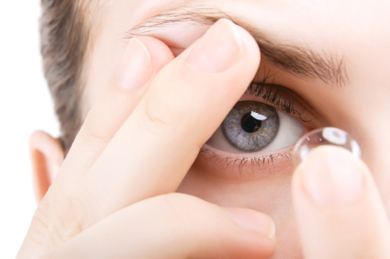New contact lenses help correct vision after continuous wear

Recently, scientists developed a new type of contact lens that can correct vision without laser eye surgery. This treatment process known as Orthokeratology, or Ortho-K, has quickly become an alternative to traditional soft contact lenses. Ortho-K is the process of corneal reshaping while a person sleeps. A patient wears special gas permeable contact lenses every night for two weeks along with daytime lenses as the patient’s vision increases. After the treatment period, GP contacts are only required at night and after additional usage; The wearer may only need to wear the contacts one or two nights a week.
Vision correcting contact lenses would be great for me and probably many other teenagers,” said sophomore Kayla Sharf. “I think they will become popular very fast among high school students.”
Ortho-K is specifically designed to help combat progressive nearsightedness in children. If a child starts wearing these lenses between the ages of eight and twelve, his or her vision will get better, and the Ortho-K treatment will prevent his or her nearsightedness from increasing. Ortho-K can also correct farsightedness and astigmatism, a distortion of the eyeball, but on a more case-by-case basis. However, some patients’ eyes cannot be corrected by Ortho-K. Most optometrists and ophthalmologists decide whether or not Ortho-K is right for each patient. Although targeted at children, Ortho-K can work for people of all ages. The younger a person is, the more likely he or she is to have the contact lenses correct more of his or her vision. Without the cloudy vision and easy tears of soft contact lenses, GP lenses offer easy and efficient eye care to children and adults alike according to doctors.
“Considering the cost and the superior vision of GP lenses, it’s actually the best choice for many patients,” Cathy Pannebaker, optometrist, said to the Contact Lens Manufacturers Association. “I believe the majority of nearsighted and farsighted patients are good candidates for GP contact lenses.”
GP contact lenses are made from fluorosilicone acrylate, a rigid plastic, and are cleaner than original soft lenses because they do not contain water. These lenses allow oxygen to travel through and reach the wearer’s cornea providing comfort and clear vision. Most people who wear soft contact lenses experience a painful feeling when they do not blink enough and their lenses dry up in their eyes. The GP lenses do not cause this problem, but may provide a small amount of pain when the user blinks. Since these contacts are designed for nighttime use, most users do not find this to be a big problem. According to the CLMA, GP contact lenses provide better vision as well as more comfort and durability than soft lenses.
Ortho-K is revolutionizing eyewear by allowing users to spend their days without the disturbances glasses and contact lenses cause. Children can use Ortho-K for a chance to reverse the burden of less-than-perfect vision caused by genetics. This scientific breakthrough soon will be able to correct vision permanently without the use of surgery.
Your donation will support the student journalists of Calabasas High School. Your contribution will allow us to purchase equipment and cover our annual website hosting costs.






